Menus
- The meaning of paradox or how to abandon Total Control for Total Taule
- 4 cylinders in line, 999 cm3, 217hp, 113 Nm, 201 kg all full facts, 24,999 euros
- How can we classify these anvils among sports ?
- Discovery: 24,999 euros
- Awesome ? The paradox lies in the answer: yes and no.
- In the saddle
- City
- Highway
- Departmental / national
- Part-cycle
- Braking
- Comfort
- Consumption
- Video test
- Conclusion
The meaning of paradox or how to abandon Total Control for Total Taule
4 cylinders in line, 999 cm3, 217hp, 113 Nm, 201 kg all full facts, 24,999 euros
"Born to race" is what Honda proclaims in large letters on the presentation sheet of the new CBR 1000 RR-R SP (the alphabet will soon no longer suffice). "Well yes, they argue, the customers of this kind of motorcycle want it more radical than ever. She uses it most of the time on the track. So we at Honda, as usual, focused on giving the best of what people want. " What people want…. No one knows, obviously. The certainty: Honda wants to kick the train of everything that moves in the Superbike world championship, in endurance and wherever we talk about sport and track. Gone are the compromises of the CBRs of the 90s / 2000s, the originality of the sporty Honda is now based on its performance and no longer on its gap with the competition.
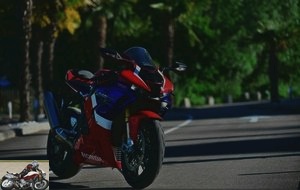 Pure power after Total Control
Pure power after Total Control
However, it would not be entirely correct to see in this the abandonment of the Total Control, this concept initiated by the master engineer of the first CBR 900 in 1992, Tadao Baba, then repeated in a loop since then to evoke the CBR. Over the years, we have lost the sense of Total Control wanted by Baba. He had received the delicate mission, at the turn of the 80s / 90s, to design a sporty Honda capable of replicating it on the GSX-R 1100 and Yamaha FZR 1000..
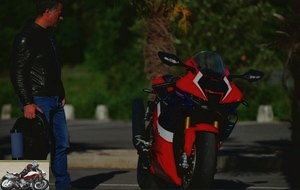 Born to race
Born to race
How can we classify these anvils among sports ?
He logically started by trying these two motorcycles: “how can we classify these anvils among sports? "He was surprised, as soon as he descended from the two monsters of the time (around 140 hp for 240 kg, roughly the values of an FJR 1300 today….). He then embarked on the development of an original, high-performance sports car, according to an idea a moment dear to Honda: the weight / power ratio and the perfection of a balanced part-cycle, which the RC 30 had already initiated. It is in fact following this path that Honda launched the NSR 500 V2 in Grand Prix in 1996..
Back to CBR. At the very end of the 80s, Tadao Baba didn’t give a damn about power, he was chasing weight. On the engine side, it starts off in a 750, but such a sports car could overshadow the VFR. And in 1000 cm3, there is already the sporty road CBR 1000 F. The displacement 900 seems to him to be a good compromise and too bad if it deprives the CBR of competition. The CBR 900 RR came out in 1992: 124 hp and 206 kg all full. She silences the bad tongues that inhibit ambitious projects (“it will never work, people want power!”) And makes headlines. The 900 becomes a quirky reference, a proposition other than the big 1000 FZR and 1100 GSX-R and it works. "The reason for being a good sportswoman on the road is to be able to have fun with it" smiles Tadao Baba. But this is not always the case with the CBR 2020 ?
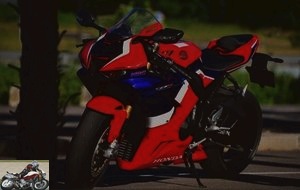 113 Nm at 12,500 rpm
113 Nm at 12,500 rpm
Discovery: 24,999 euros
Yes, as we will see in the course of the test. But in the thirty years between the 1992 900 and the 2020 1000, it’s not so much that the CBR no longer corresponds to Total Control, but rather that all of its competitors have long been doing it. ZX-10R, R1, Ducati Panigale etc. all sail around 200 kg for 200 hp, packed with electronics and improvements to make a GP rider of the 2000s pale. Easy to handle (if we put aside the driving position inherent in these motorcycles), often well balanced, they are scary today because of their absurd power. But let me remind you that power is just a potential that activates your right wrist. No obligation to use all the cavalry for fun. Ok, that’s frustrating and besides the CBR 1000 RR-R SP suffers more than any other, with its 217 high-pitched hp and disproportionately long gear ratios..
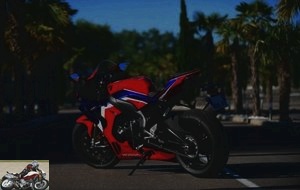 PGM-DSFI dual electronic injection, 52mm injection body
PGM-DSFI dual electronic injection, 52mm injection body
In short, if the first CBR appeared as a benchmark in terms of control thanks to its chassis, it gradually lost its primacy when the competition caught up with it, while continuing the quest for horses. . The 900 pointed the way but only partially followed it, the brand refusing to enter the round of mad horses.
Honda wanted to regain control with the new CBR and did it in a less original way this time, returning to its principles: volo power and high-end equipment, hence a staggering price of 24,999 euros for the SP and 21,999 euros for the "entry level" RR-R.
The new engine, with dimensions identical to Marquez’s MotoGP but with a completely different architecture (four cylinders in line while the MotoGP has a V4, expensive to produce in series), sparkles with the most diamonds of high tech mechanics: connecting rods in titanium (with a small birth defect on a certain type but which has already been corrected by Honda, hence a delay in marketing), A2618 aluminum pistons, friction reduced to the maximum (DLC treatment on cams), valves driven by pawls (less friction and more flexibility in engine design), mixed distribution by chain and pinion…. All this helps lighten the moving masses, reduce friction and gain more revs: the CBR can go up to 14,500 rpm before entering the red zone. You want potatoes per kilotonne, well, there you go.
 4 cylinders, 999.7 cm3 (81 x 48.5 mm)
4 cylinders, 999.7 cm3 (81 x 48.5 mm)
This new engine, reduced in size compared to the old CBR, is embedded in a completely new chassis. Diamond-type double-beam frame made from 2 mm aluminum sheets "which allow great freedom in the definition of points and areas of rigidity" argues Honda. Weight distribution revised, thanks to a crankshaft set back by 33 mm and raised by 16 mm to improve agility. Swingarm designed from that of the GP RC213V. The core values of the chassis have increased to increase stability: wheelbase of 1455 mm (against 1405 previously) and 102 mm caster, for a weight of 201 kg fully loaded. The CBR 1000 SP is therefore almost 100 hp more than the CBR 900 of 1992, with 5 kg less. !
Awesome ? The paradox lies in the answer: yes and no.
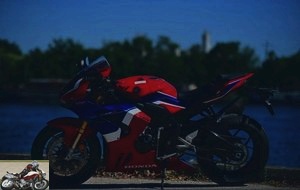 201 kg in running order
201 kg in running order
In the saddle
The raised stern requires a good lift of the leg. Once in place, you have to bend to catch the low bracelets, you can tell that the Paris-Biarritz by the departmental is not its thing (we are not talking about the duo, ok?). The saddle is long, but thin at the level of the reservoir, which is quite short and does not require you to extend your arms. The footrests placed high enough impose a rather pronounced bend of the legs. Typical position of the racing bike, which allows you to dominate the front axle and to move with ease. The tone is set, it will have to go quickly otherwise it will be torture.
Starting with the key in the pocket (transponder), by manipulating a module placed on the left side of the dashboard. The titanium exhaust leaves the four-cylinder hissing, the dashboard does not even indicate the revs under 5,000 rpm in the configuration I have chosen, which indicates the speed in full (we will quickly understand why). Other configurations allow you to choose different interfaces, basically you choose the config ‘of the dashboard (which has the good idea to change the background color according to the brightness).
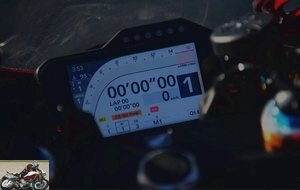 Fully digital dashboard
Fully digital dashboard
The whole shows a nice finish, it’s tough. The controls are smooth, but the clutch lever (cable operated) is not adjustable. The bubble barely reaches my chest (despite my meter sixty-eight), the motorway will not be his thing either ….
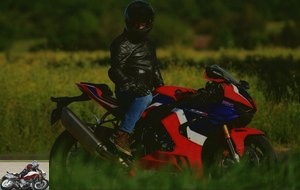 Flash !
Flash !
City
The city (city?) Is akin to a penitentiary for the CBR. When stopped, when it’s hot, the engine gives off quite a bit of heat. Despite the smoothness of the bike, the seat height remains quite high, despite the 830 mm announced, for small sizes like me. But a big one won’t be better, bent over backwards.
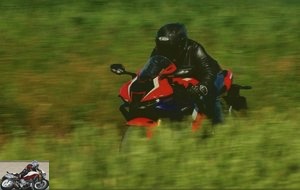 Long reports
Long reports
Above all, the driving position with strong support on the wrists annoys. One should hardly hope to be able to pass the second report, the first assembly largely above 100 km / h and the long transmission ratios favor the “single-report”. Some positive points anyway: the mirrors remain legible, the agility of the bike helps to slip through or change direction at the last moment, the progressive braking is reassuring. Next.
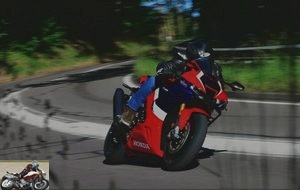 217.5 hp (160 kW) at 14,500 rpm
217.5 hp (160 kW) at 14,500 rpm
Highway
A great opportunity to test your patience and self control! On the motorway, you have to start by finding your ideal driving position. For me, it’s picked up, with my torso on the tank, alternating pressure on the knees to relieve the wrists and vice versa. The small bubble protects poorly but the long saddle allows you to vary the positions. But the worst part is the temptation! At 130 km / h in sixth, the CBR is bored at 5,000 rpm. At 140, the tachometer lapses at 5,500 rpm. Either below the fateful threshold that I will tell you about later. Sometimes I crack and pray, just to enjoy the magical sound above 6,000rpm and 11,000rpm, envision penitentiary hell, the real one. Advantage, at 5,000 rpm, it consumes less than 6 l per 100.
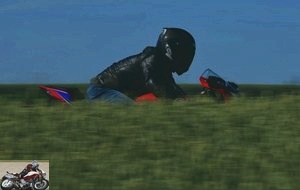 Stealth mode
Stealth mode
Departmental / national
If there is heaven for the CBR on the road, then it must be there. These places, chosen more or less deserted and virolent, offer me the opportunity to answer the question asked above (great CBR on the road) and to clarify my Norman answer. In my opinion, there are two aspects to the CBR, like any motorcycle: the chassis and the engine. However, it has no homogeneity at this level.
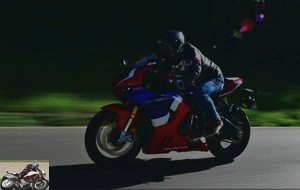 Low windshield even for a small size
Low windshield even for a small size
Easy, intuitive, as stable as it is manoeuvrable, the Honda’s balance makes you want to play as much as it gives you confidence. The piloted suspensions of the SP version (Ohlins NPX fork and TTX 36 shock absorber with Smart EC system, controlled by the OBTI interface), of which I have kept the mode 1 parameters (everything is adjustable at will via the dashboard, with three pre-configured modes), show a certain dryness in compression, well compensated by an excellent, progressive rebound, which does not destabilize the bike. On bumps, under braking, under acceleration, the bike does not let itself be fooled. Above all, it has a rare quality, which I like on sports cars: a light and neutral front end which nevertheless remains stable in all conditions. I went at 90 km / h on a rutted secondary road (never seen that!), No steering, or even the start of a movement. Of course, the HESD electronic steering damper helps. In large, fast curves, the front does not register with the arms, ZX-10R or GSX-R style, it guides itself, it positions itself. Angle changes are easy, by simply pressing down on the footrests, CBR is not physical.
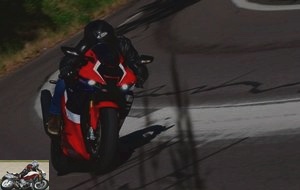 Its terrain: small twisty roads
Its terrain: small twisty roads
The engine, on the other hand, hollow below 6000 rpm (for a 1000, all these remarks are always relative to the category to which the CBR belongs), only wakes up beyond, when the valve on the exhaust releases it (to the ear, it’s clear). Except that in third, at over 6,000 rpm, we are already far from the authorized 80 km / h. Long gears, coupled with this engine whose power is high perched, do not correspond to road use. I will be told that it is the same for all sports, but on the CBR it is worse. The Yam ’R1 has the advantage of a fairly beefy engine at mid-range, thanks to its Crossplane tuning and a rewarding tone. The trunk of the GSX-R 1000 also lends itself better to the road.
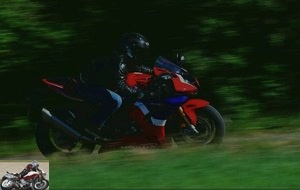 To be exploited high in the towers
To be exploited high in the towers
The CBR therefore makes you want to take advantage of its brilliant chassis, but then you have to use the engine between 8,500 (second level) and say 12,000 rpm (the 14,500 are almost impossible to achieve on the road, more or less reasonably) , or at speeds that bring us back to the 90s…. or in the penitentiary. We often stay on the same gear, which is a shame, the up & down shifter works perfectly. Another parameter, the restrictive driving position also makes you want to drive fast.
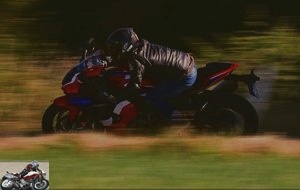 Extraordinary cycle part
Extraordinary cycle part
The paradox of the CBR is nested in this double face, a part-cycle adept of Total Control and a engine follower of Total in Taule. Honda does not hide it, its destiny is on the circuits. When I got home, I looked on an advertisements site known for all the prices of the 125 and 250 two-strokes of my youth and the current 400 four-strokes, the only solution in my opinion to have fun on the road without crossing cars at 200 km / h.
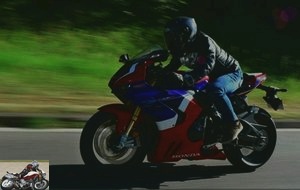 Top performance
Top performance
Part-cycle
To sum up: the alliance between agility and stability comes together in a rare peak for a big sportswoman. After trying it on the circuit with slick tires, when it was presented last February, I was worried about some nervousness on the road with the standard Bridgestone RS 11s. It is not, far from it. Contained by the anti (skating, wheeling, intelligent ABS, all managed by a Bosch 6-axis power plant), but above all by its natural balance (distribution of masses and quality of its suspensions), the CBR 1000 is at the top. Perhaps it is a little behind compared to a Ducati Panigale in feeling of lightness, but it is to be verified.
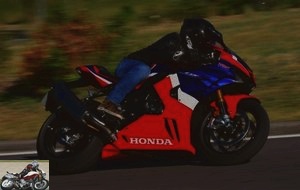 CBR is not physical
CBR is not physical
Braking
Again, no complaints, the Brembo calipers and 330mm wide front discs deliver power and progress without the ABS triggering at a brisk pace. The rear brake is a bit shy. During braking phases, the CBR does not separate, always benevolent.
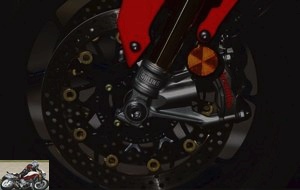 Double hydraulic disc ш 330 mm with Brembo 4-piston radial calipers, full ABS anti-lock
Double hydraulic disc ш 330 mm with Brembo 4-piston radial calipers, full ABS anti-lock
Comfort
The suspensions take shocks well, we are not too shaken up, but the driving position is radical. Detail: nothing is housed under the passenger seat.
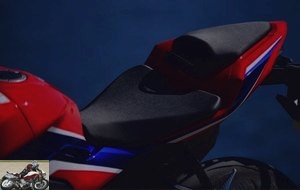 Anecdotal seat for the passenger
Anecdotal seat for the passenger
Consumption
The bike was 400 km when I took it, with fuel. 170 km further, I added 11.7 liters to the tank which contains 16. Either a consumption of about 6.7 l / 100 km, consistent with the rest of the test, mixing a little city, a lot of road and quite a few freeways.
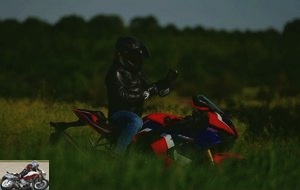 To be exploited in Germany
To be exploited in Germany
Video test
Conclusion
Two CBRs have stood out in the history of this sporty model: the 900 from 1992 for its quirky side, with its avant-garde contained weight and this new CBR 1000, for its crazy power and its easy and neutral part-cycle. . Honda was fed up with being banished by competition from a sporting point of view, they shouldn’t be upset, the engineers let go. It will surely be spectacular on the track, but on the road, the CBR 1000 is extremely frustrating, even more than the R1, Panigale and others. Its engine makes it necessary to seek revolutions / minutes which are not conceivable on earth and even less in "the world after". As a result, you rarely have the opportunity to take advantage of its brilliant part-cycle. The circuit remains its only way out. But at what price: 25,999 euros for the SP, 21,999 euros for the version without piloted suspensions (Showa for the latter).
Strong points
- Part-cycle
- Finishing
- Electronic
- Powerful
Weak points
- Inordinately long reports
- High power
- Price
The technical sheet of the CBR 1000 RR-R Fireblade
Test conditions
- Itinerary: small varied roads + interurban highways with a bit of town
- Motorcycle mileage: 300 km
- Problem encountered: to add urgently to Santa’s list, but with the crisis I’m afraid he will refuse me.
Related articles
-
Honda Africa Twin CRF1100L Adventure Sports motorcycle test
100 hp, 105 Nm at 6,250 rpm, 238 kg all full (250 kg in DCT / EERA), 16,899 euros (19,399 euros in DCT and EERA suspensions). The spirit is there It…
-
BMW F 850 GS Adventure motorcycle test
Altitude Twin cylinder in line, 853 cm3, 95 hp, 92 Nm, 244 kg all full facts, 13,300 euros without option. The BMW F series started with single…
-
Kawasaki Versys 1000 S Grand tourer motorcycle test
Daily test for fifteen days 1,043 cm3, 120 hp at 9,000 rpm, 102 Nm at 7,500 rpm, 257 kg, 15,099 euros (17,099 euros Grand Tourer version) This bike, to…
-
Kawasaki Ninja ZX-10R KRT motorcycle test
An integer character 4 cylinders in line, 998 cm3, 203 hp, 114.9 Nm, 206 kg all full facts, 18,099 euros. Nice surprise for me to find the Kawasaki…
-
Honda CBR 1000 RR Fireblade test
The era of e-Total Control A quarter of a century has seen the evolution of one of the most efficient and unique sports cars in the segment: the CBR…
-
The trail for all Completely revised both in terms of aesthetics and part cycle, the new VFR800X Crossrunner asserts itself through an efficient,…
-
Honda NC 700 X motorcycle test
Transgenic camel Discovered at the Milan Motor Show, the Honda range is enriched with a new range of 3 midsize machines, available on the same chassis…
-
Honda CBR 600 RR motorcycle test
1700 km test The CBR 600 RR is the Honda hypersport, the ultimate weapon of the Hamamatsu firm, whose lineage with the RC211V is evident. The 2010…
-
Honda CBR 600 F motorcycle test
We were used to undressed sportswomen who turn into roadsters. Honda does the opposite by offering the CBR 600 F, a Hornet that is dressed in a fairing….
-
Honda CBR 1000 RR Fireblade motorcycle test
20 years under the sign of total control 1992 saw the appearance of the very first CBR Fireblade, cubing 893 cm3 and has since become a sports icon. At…
for some time in the Honda is decidedly subscribed to commercial failures, they no longer know how to make a sports car that sells and this one will not escape the rule. it becomes a curse !
Honda dealers will still be happy, we are going to require them to put one on demo to do some sales. But the problem is, a lot of dealers still have the 2017 demos for sale.
Good evening at the lair
A good, very detailed and eagerly awaited report concerning me is great !!
On the other hand a shell has slipped into the braking part, you speak of Brembo calipers on 330mm discs while according to the photo, your legend and Kawasaki it is about Nissin calipers on 310mm disc….
V
Customers don’t jostle each other, me
The first, because the companies
Insurance torpedoed, by their
Prices, this so-called sport category.
Just have a fairing…
So that the price is doubled at least.
Too good this essay !
40 years that I have been riding a motorbike I have the 2009 zzr 1400 motorbike nickel in all respects the best machine that I have had friendly joel
Try to redo now in full !!!
Hello. For my part I just spent my ZZR 1400 from 106 to 200hp. As my life warned my Kawasaki dealer, it’s a whole different machine that comes into my hands. the arms, once the 6000 revolutions minutes have passed, are at the limit of breaking. I have to forget everything I had learned about this bike to discover a new one. The bike remains extremely manoeuvrable and we feel safe in curves despite its weight of 268 kg which gives us the impression of having the wheels glued to the ground. I still have to learn to master this impressive power while trying to keep my driver’s license. For my part, I think this bike is a real success for Kawasaki and I am very satisfied with my purchase.
The sophistication. It’s complicated these super powerful and super efficient machines on the circuit.
Honda reigns in endurance racing again…?